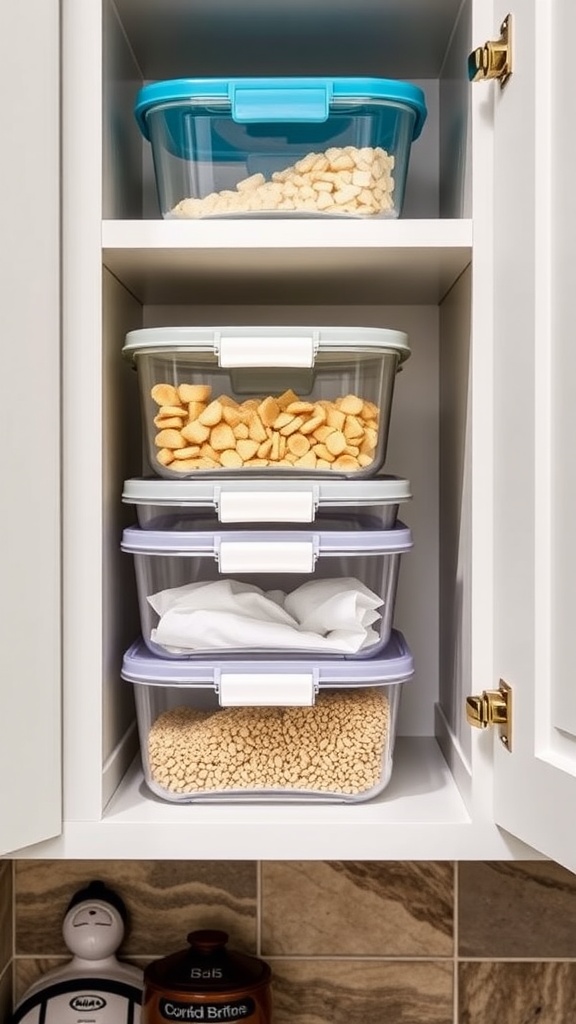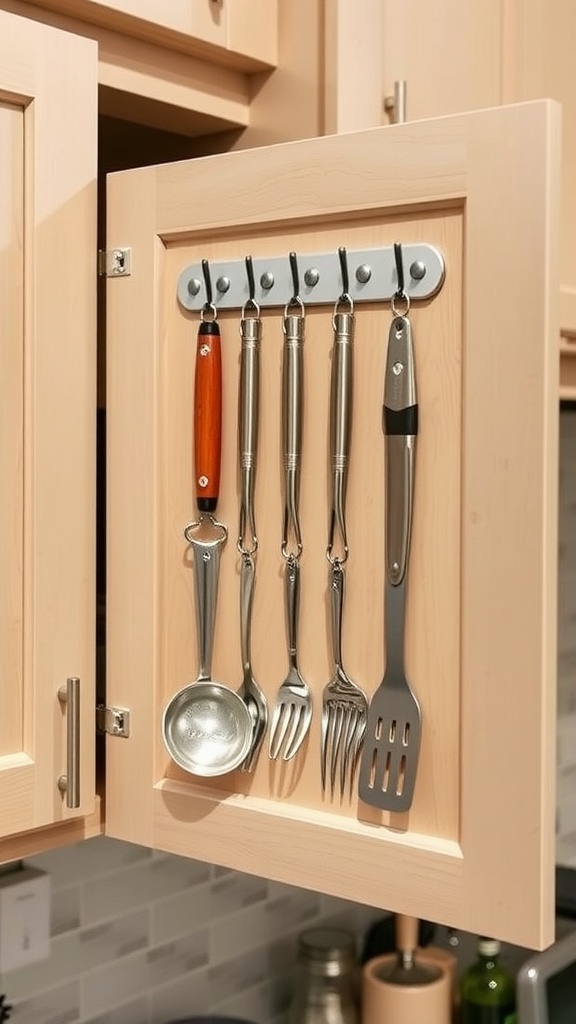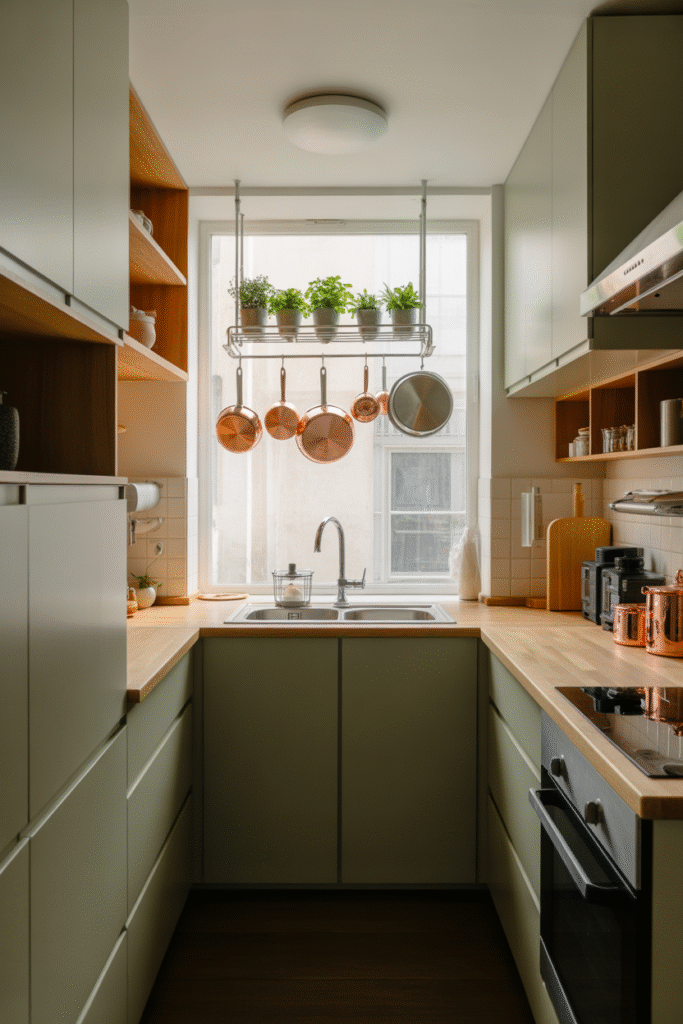You’re not the only one who has ever felt like your small kitchen was against you. Small rooms can get crowded and disorganized very quickly, but if you know how to store things correctly, even the smallest kitchen can work like a dream. This book gives you smart, low-cost tips on how to make the most of every space in your kitchen.
Every drawer, closet, and table space in a small kitchen is important. It’s not enough to just fit more things; the goal is to make the room feel open, well-organized, and fun to cook in. That means changing how you put things, using spaces you might not have thought of before, and adding tools and furniture that can be used for more than one thing. You don’t have to do a full makeover to make your kitchen more useful. All you need are a few smart changes.
The tips in this guide will help you get the most out of your space, whether you live in a studio apartment, a cozy home, or just a small kitchen that needs some work. You’ll learn how to make your kitchen feel twice as big, clear up your plan, and save space with vertical storage hacks, drawer organizers, and pull-out shelves.
1. Use Vertical Space Like a Pro
Look up! Walls offer valuable real estate. Install:
- Floating shelves for everyday items or decor.
- Magnetic knife strips or pegboards for utensils and tools.
- Wall-mounted spice racks to free up cabinet space.
If you don’t have a lot of table room, look up. In most kitchens, empty walls are a waste of space. But in a small kitchen, vertical space is your best friend. Don’t just use cabinets; use every inch of space from the bar to the roof. Shelves that are attached to the wall, racks that hang from the ceiling, and pegboards are all useful ways to store things that don’t take up any floor room.
Open shelves are a great way to store things that you use often, like dishes, mugs, and jars of dry goods. They make the space feel lighter and airier, and they’re also useful. This is especially true if you style them with care. To make a neat and appealing display, you could stack white plates, line up spice jars, or add a small plant.
Don’t forget to clean the inside of your cabinet doors and the space above your upper drawers. Hooks, baskets, and sticky organizers can be used to put oven mitts, lids, tools, or even cutting boards where they don’t belong. You can also hang a pot rack or put up a magnetic knife strip to make drawers and counters less crowded. When you think vertically, you can add more storage space without making the room too crowded.
Tip: Put up hanging shelves with strong frames and put heavy things on the bottom shelf to keep the room safe and level.

2. Choose Stackable and Nesting Storage
Maximize cabinets and drawers with:
- Stackable containers for dry goods or leftovers.
- Nesting bowls, pots, and pans that take up less room.
- Adjustable shelf risers to double vertical cabinet space.
There isn’t much room in a small kitchen, so every inch counts, especially inside the cabinets and drawers. That’s where storage options that stack or nest really shine. You can store more in less space with these space-savers, which are made to make the most of narrow closets and shelves without making a mess.
Containers that can be stacked, especially those with clear sides and lids that keep air out, help keep everything from dry goods to leftovers organized and make the most of vertical closet space. Pick the same sizes so they stack nicely, and clearly name them so you don’t have to guess. Whether you’re cleaning out your kitchen or putting away baking supplies, stackables give a mess of things some order.
When not in use, nesting items like cooking bowls, measuring cups, and even food storage bins take up less space because they can fit inside each other. You don’t have to spread these things out on several shelves; you can put them all in one small area. Look for stacking sets with lids that snap together or that come in different sizes so that everything stays in its place and is easy to get to.
Tip: Use only one or two brands of bowls and containers so that your things stack more tightly and look more similar. This makes the space look more calm and planned.
Pro tip: Label your containers for quick access and a clean look.

3. Add Over-the-Sink or Stove Shelving
These underused areas can store dish soap, spices, or utensils. Try:
- An over-the-sink shelf for sponges and plants.
- A stove-top shelf for salt, oils, or cutting boards.
When you have a small kitchen, it’s important to make the most of odd spaces. One of the most underused places is right above your sink or stove. Putting up shelves or storage racks in these places will not only give you more room, but it will also keep your most-used things close at hand.
Over-the-sink shelves are great for small kitchens that don’t have a lot of table room. You can put soap holders, brushes, small herb pots, or even pretty things to make the room feel cozier in them. Some types can be expanded and sit right on the edges of the table, so they’re easy for renters to use and don’t need to be drilled in.
A narrow spice rack or metal shelf above the stove can make it easy to get to oils, herbs, or cooking tools. Just make sure the materials can handle heat and are simple to clean. If your range hood has room above it, you could add a small shelf or magnetic rack to hold small items or decorations that are easy to move.
Tip: In these places, use open metal or glass shelves to keep the look light and help your kitchen not feel squished. Pick materials that are simple to clean up if they get wet or steamy.
4. Install Pull-Outs and Roll-Out Drawers
Deep cabinets can become black holes. Adding pull-outs makes everything accessible:
- Pull-out pantry racks fit into skinny gaps.
- Sliding drawers under the sink or inside lower cabinets.
- Rolling carts that tuck into corners or double as prep stations.
Putting in pull-out shelves or roll-out drawers in your cabinets is one of the best ways to quickly make your small kitchen more storage- and access-friendly. You don’t have to dig through the back of a dark, deep closet to find a single pot or spice jar because of these smart moving parts.
Pull-out organizers work great in lower cabinets with deep corners that aren’t used very often. To make more room on the floor, you can put up stacked racks for canned goods, trays for baking sheets, or even a trash and recycling system that slides. Roll-out drawers work the same way regular drawers do, but they are fixed inside a cabinet box. This makes the most of the vertical room in the cabinet and keeps things neat and easy to get to.
A pull-out spice rack or pantry tower can make even small areas, like the space between your fridge and the wall, very useful. You can use these thin slide-outs in places that are too small for regular shelves but too useful to waste. When you add these storage changes, you can reach every part of your cabinets. You won’t have to bend over or remember what you put in the back.
Tip: Soft-close hardware will make your pull-outs look more high-end and will also help your cabinets last longer by being used less harshly.
5. Use the Inside of Cabinet Doors
Hidden but handy:
- Stick-on bins for wraps, sponges, or dish gloves.
- Hooks or rails for measuring spoons and pot lids.
- Clipboards or notepads for grocery lists.
If you have a small kitchen, the inside of your cabinet doors is a goldmine of unused store space. You can turn these secret areas into very useful areas with the help of some cheap items like sticky hooks, small racks, or slim organizers.
To hold small jars and pepper packets neatly, you can place a spice rack or clip system inside your cabinet doors near the stove. You could add a basket to your under-sink cabinet to hold cleaning tools, trash bags, or extra sponges. You can even put in a paper towel holder or a slim box to keep foil and wraps close at hand without making your drawers too crowded.
You can also use this trick in your kitchen. Putting clear plastic pockets or light bins on the inside of closet doors can help you find snacks, gravy packets, and zip-top bags that get lost in bigger containers. Also, having these things at eye level when you open the closet makes it easier to clean and cook.
Tip: Depending on how solid you want the fix to be, use glue or screws. Also, make sure to measure the door’s space so it can still close properly after installation.

6. Try Furniture with Hidden Storage
If you have a dining nook or kitchen island:
- Choose a bench with storage inside.
- Look for an island with shelves or drawers.
- Use bar stools that tuck in completely to save floor space.
When every inch counts, furniture that can be used for more than one thing and has secret storage can make a big difference in a small kitchen. Think of pieces of furniture that can be used for their main purpose, like a desk or chair, but also hides smart storage spaces. It’s an easy way to make things more useful without making them look cluttered.
People often choose a kitchen bench or cart with shelves, drawers, or bins built in underneath. These give you a place to prepare meals and store things like pots, pans, sheets, and even kitchen essentials. A lot of islands now have trash cans that pull out or cutting boards that can be extended, which adds even more value to a small space. If you don’t have room for a fixed island in your kitchen, think about getting one with wheels that you can move around and store when not in use.
You can also add storage chairs and banquettes to eat-in kitchens. You can store things you don’t use very often on a bench with a lift-up lid, like holiday dishes, extra paper towels, or huge amounts of food. You can even get stools and ottomans with hollow innards that are great for hiding things like cleaning supplies, plates, or bags. These ideas will help you keep your important things close without giving up style or room.
Tip: Pick furniture with simple shapes and earthy colors to keep your kitchen from looking too crowded. This will make it feel light and airy while still being fully useful.
Final Thoughts
A small kitchen doesn’t mean it can’t be used well. If you know how to store things right, you can turn even the smallest room into a stylish, well-organized hub of your home. You can find secret possibilities in every corner if you think vertically, use areas that aren’t often used, like cabinet doors and sink areas, and add furniture that can be used for more than one thing.
Staying focused is key. Put what you use most first, spend money on smart solutions that work for you, and don’t be afraid to get creative. Every little change you make to your kitchen, like putting in new drawers, a rail system, or a storage bench, makes it work better and feel better overall.
Remember that making the most of your space isn’t just about storage; it’s also about making a kitchen that fits your style, supports your habits, and makes you happy every time you walk in.

